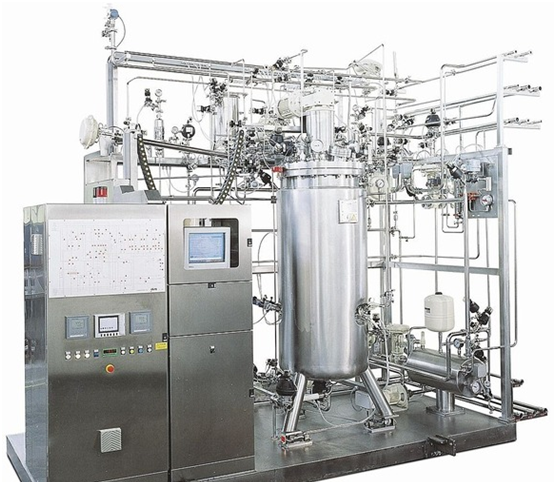Batch fermentation is defined as the liquid fermentation process in which the culture is inoculated into a sterile medium contained in a closed vessel. In batch fermentation process, there is no addition of nutrients once the fermentation process starts. This type of fermentation process can also be known as a closed-culture system – since there are no nutrient additions once the process is started. Environmental and/or physical parameters vital for the growth of the organism, such as pressure, temperature, pH and aeration (oxygen supply) are usually controlled and regulated in batch fermentation process.
In batch fermentation, the growth nutrients and other additives for the fermentation process are added in the required amounts in the beginning of the fermentation. Once the sterile medium in the fermentation vessel is inoculated with the appropriate culture or microorganism of interest, it passes through a number of growth phases including lag phase (where there is no growth; but acclimatization of the organism to the new environment it was introduced to); log/exponential phase (where there is increased microbial growth and buildup of microbial biomass); stationary phase (where growth ceases because of nutrient depletion) and decline/death phase (where the cells begin to lose their viability).
The microorganisms grow at a rapid (exponential) rate due to the availability of excess nutrients in the fermentation vessel. There is no refill of nutrients once the fermentation process has started and the end-product is recovered at the end of the process. The microbes increase in number with rapid use of the available nutrients and simultaneously produce toxic metabolites. The growth of the microbial cells slow down during the end of the fermentation process; and this is usually due to nutrient depletion and the buildup of toxic metabolites – which affect microbial growth.
Once the batch fermentation process is completed, the fermentation vessel is cleaned properly, and then sterilized before it is used for another batch fermentation process. It is noteworthy that oxygen is usually added in a batch fermentation system (to activate and spur the growth of aerobic microbes). Anti-foaming agents (which takes care of foam formation) and acids or bases (which controls the pH) of the fermentation vessels can also be added even though nothing is usually added in the entire course of a batch fermentation process (closed-culture system).
Batch fermentation is usually applied in fermentation processes in which one fermenter is used to make various products; in fermentation processes in which only small amounts of the desired product is produced; and in fermentation processes in which the product must be produced with minimal risk of possible contamination or any alteration in the genetic makup of the microorganism.
Generally, batch fermentation is characterized by an initial charging of the fermentation media with an appropriate inoculant (microorganism); and the product is withdrawn or recovered at the end of the fermentation process – without any addition of nutrient during the process. Batch fermentation is characterized by some merits and demerits.
MERITS OF BATCH FERMENTATION
- Batch fermentation is more flexible with many biological systems and/or products.
- There is reduced risk of contamination of the process – since nutrients are only added once at the start of the process.
- Mutation of the microbial cell is minimal since the process does not last for a long time.
- Batch fermentation process is cost effective and thus requires low capital to set up.
- There is usually a higher conversion of the raw materials in batch fermentation systems than in other fermentation processes. And this is usually because the growth process in batch (closed-culture) fermentation process is controlled.
DEMERITS OF BATCH FERMENTATION
- The frequent sterilization of the fermentation vessel used for batch fermentation makes the process to have an increased focus on instrumentation.
- Batch fermentation is capital intensive since it requires more labour and resources for process control.
- There is also a lower productivity levels as a result of the time it takes to sterilize, clean, empty and fill the fermentation vessel.
- Several subcultures are usually prepared for inoculating a batch fermentation vessel; andthis increases the cost of operating the process.
References
Bader F.G (1992). Evolution in fermentation facility design from antibiotics to recombinant proteins in Harnessing Biotechnology for the 21st century (eds. Ladisch, M.R. and Bose, A.) American Chemical Society, Washington DC. Pp. 228–231.
Nduka Okafor (2007). Modern industrial microbiology and biotechnology. First edition. Science Publishers, New Hampshire, USA.
Das H.K (2008). Textbook of Biotechnology. Third edition. Wiley-India ltd., New Delhi, India.
Latha C.D.S and Rao D.B (2007). Microbial Biotechnology. First edition. Discovery Publishing House (DPH), Darya Ganj, New Delhi, India.
Nester E.W, Anderson D.G, Roberts C.E and Nester M.T (2009). Microbiology: A Human Perspective. Sixth edition. McGraw-Hill Companies, Inc, New York, USA.
Steele D.B and Stowers M.D (1991). Techniques for the Selection of Industrially Important Microorganisms. Annual Review of Microbiology, 45:89-106.
Pelczar M.J Jr, Chan E.C.S, Krieg N.R (1993). Microbiology: Concepts and Applications. McGraw-Hill, USA.
Prescott L.M., Harley J.P and Klein D.A (2005). Microbiology. 6th ed. McGraw Hill Publishers, USA.
Steele D.B and Stowers M.D (1991). Techniques for the Selection of Industrially Important Microorganisms. Annual Review of Microbiology, 45:89-106.
Summers W.C (2000). History of microbiology. In Encyclopedia of microbiology, vol. 2, J. Lederberg, editor, 677–97. San Diego: Academic Press.
Talaro, Kathleen P (2005). Foundations in Microbiology. 5th edition. McGraw-Hill Companies Inc., New York, USA.
Thakur I.S (2010). Industrial Biotechnology: Problems and Remedies. First edition. I.K. International Pvt. Ltd. New Delhi, India.
Discover more from #1 Microbiology Resource Hub
Subscribe to get the latest posts to your email.



